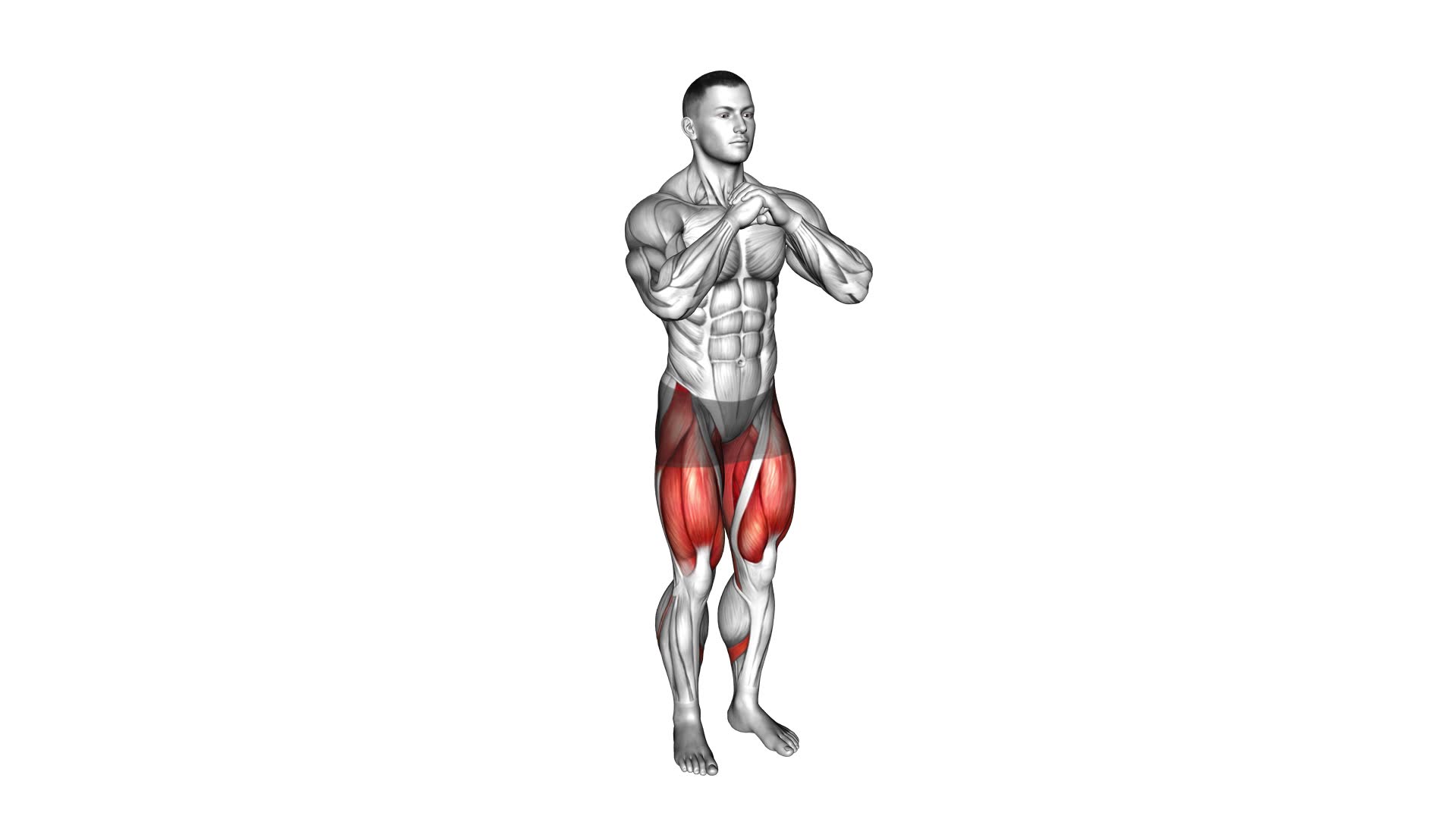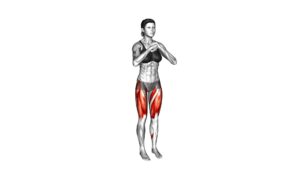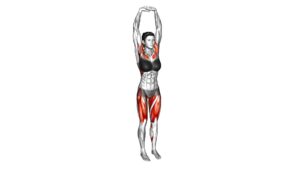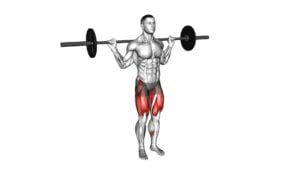Curtsy Squat – Video Exercise Guide & Tips

Are you looking to tone your legs and sculpt your glutes? Look no further than the curtsey squat! This exercise targets multiple muscle groups and can be easily incorporated into your workout routine.
Watch This Exercise Video
In this video exercise guide, we'll show you the proper form and technique, common mistakes to avoid, and even some variations and progressions to keep challenging yourself.
Get ready to feel the burn and maximize your results with these curtsey squat tips!
Key Takeaways
- Curtsey squats strengthen and tone the lower body, targeting multiple muscle groups including the glutes, quadriceps, hamstrings, and inner thighs.
- Proper form and technique include standing with feet hip-width apart, stepping the right foot diagonally behind the left leg, and lowering the body until the left thigh is parallel to the floor.
- Common mistakes to avoid include not maintaining proper alignment of knees with toes, failing to engage core muscles, and neglecting proper technique.
- Variations and progressions of curtsey squats include split squats, weighted curtsey squats, plyometric curtsey squats, and single-leg curtsey squats, allowing for adjustments in intensity according to fitness level.
Benefits of Curtsey Squats
To understand the benefits of curtsey squats, you should know that they can help to strengthen and tone your lower body. Curtsey squats are a versatile exercise that targets multiple muscle groups, including your glutes, quadriceps, hamstrings, and inner thighs. By incorporating curtsey squats into your workout routine, you can improve your overall lower body strength and enhance your athletic performance.
One of the main benefits of curtsey squats is that they engage different muscles compared to traditional squats. This variation activates your glutes and outer thighs more intensely, helping to sculpt and shape your lower body. Additionally, curtsey squats can improve your stability and balance, as they require you to shift your weight from side to side.
Another advantage of curtsey squats is that they can be modified to suit your fitness level and goals. You can perform them using only body weight, or you can add dumbbells or a barbell for added resistance. You can also experiment with different foot positions and ranges of motion to target specific areas of your lower body.
Incorporating curtsey squats into your workout routine can provide numerous benefits, including increased lower body strength, improved stability and balance, and enhanced muscle definition. Whether you're a beginner or an experienced fitness enthusiast, adding curtsey squats to your exercise regimen can help you achieve your fitness goals.
Proper Form and Technique
To perform curtsey squats with proper form and technique, follow these guidelines:
- Stand with your feet hip-width apart and engage your core.
- Step your right foot diagonally behind your left leg, crossing it as if you were doing a curtsey.
- Bend both knees, keeping your weight in your left leg and your torso upright.
- Lower your body until your left thigh is parallel to the floor, making sure your right knee hovers just above the ground.
When performing curtsey squats, it's important to be aware of some common misconceptions. One misconception is that curtsey squats only target the glutes. While they do primarily work the glutes, they also engage the quadriceps, hamstrings, and inner thighs. By crossing one leg behind the other, curtsey squats activate multiple muscle groups, resulting in a more effective and efficient workout.
Now that you know the proper form and technique for curtsey squats, let's move on to the next section: common mistakes to avoid.
Common Mistakes to Avoid
Avoid these common mistakes when performing curtsey squats to ensure proper form and maximize the effectiveness of your workout.
One common mistake isn't maintaining proper alignment. When performing a curtsey squat, it's crucial to keep your knees aligned with your toes and avoid letting them cave inwards. This helps to protect your knee joints and prevent injuries.
Another mistake to avoid isn't engaging your core. Your core muscles play a significant role in stabilizing your body during the exercise. Failing to engage your core can lead to poor form and decrease the effectiveness of the squat.
Additionally, be cautious of not going deep enough with the curtsey squat. It's essential to lower your body to a point where your front thigh is parallel to the ground. This ensures that you're engaging your glutes and leg muscles fully.
Lastly, rushing through the movement is another common mistake. Take your time and focus on performing each curtsey squat with control and precision. Remember, proper technique is key to getting the most out of your curtsey squats and avoiding unnecessary strain or injury.
Variations and Progressions
Maintaining proper form and maximizing the effectiveness of your curtsey squats can be achieved through various variations and progressions. Here are some curtsey squat modifications and challenges to help you take your workout to the next level:
- Split Squats: Instead of crossing one leg behind the other, step one foot forward and the other foot backward. This variation focuses more on the front leg, increasing the intensity of the exercise.
- Weighted Curtsey Squats: Hold a dumbbell or kettlebell in each hand to add resistance and challenge your muscles further. Start with lighter weights and gradually increase as you get stronger.
- Plyometric Curtsey Squats: Incorporate explosive movements by jumping and switching legs mid-air during each rep. This modification increases power, cardiovascular endurance, and calorie burn.
- Single-Leg Curtsey Squats: Lift one foot off the ground and perform the curtsey squat on the opposite leg. This variation improves balance, stability, and targets each leg individually.
By incorporating these curtsey squat variations and challenges into your routine, you can diversify your workout, target different muscle groups, and continue to progress towards your fitness goals.
Remember to listen to your body and adjust the intensity according to your fitness level.
Incorporating Curtsey Squats Into Your Workout Routine
To maximize the benefits of curtsey squats and incorporate them into your workout routine, consider adding them to your lower body strength training sessions. Curtsey squats are a great exercise for targeting the glutes, quads, and inner thighs. They can help improve your balance and stability while also building strength in your lower body.
If you're looking to modify the curtsey squat, you can try holding onto a wall or a chair for support. This can help with balance and make the exercise more accessible. Another modification is to use lighter weights or no weights at all if you're a beginner or if you're recovering from an injury.
If you want to switch things up, there are also alternative exercises that target similar muscle groups. Lunges, side lunges, and reverse lunges are all great options. These exercises can provide a similar challenge to the curtsey squat and help you continue to strengthen your lower body.
Incorporating curtsey squats into your workout routine can be a great way to add variety and target different muscle groups. Whether you choose to do the traditional curtsey squat or modify it to fit your needs, these exercises can help you achieve your fitness goals.
Tips for Maximizing Your Results
To maximize your results with curtsey squats, it's essential to focus on proper form techniques. This means keeping your back straight, knees aligned with your toes, and engaging your glutes and thighs throughout the movement.
Additionally, incorporating effective training strategies like increasing resistance or adding variations can help challenge your muscles and promote growth.
Lastly, don't forget the importance of recovery and rest days to allow your body to repair and rebuild, ensuring optimal results from your curtsey squat workouts.
Proper Form Techniques
To maximize your results during a curtsey squat, focus on maintaining proper form and technique throughout the exercise. Here are some technique tips and common mistakes to avoid:
- Keep your feet hip-width apart and your toes pointing forward.
- Begin by standing tall with your chest lifted and shoulders relaxed.
- As you squat, keep your weight evenly distributed between both legs.
- Make sure to keep your knees aligned with your toes and avoid letting them collapse inward.
Maintaining proper form is crucial for targeting the right muscles and preventing injuries. By following these technique tips, you can ensure that you're getting the most out of your curtsey squats.
Now, let's move on to the next section, where we'll discuss effective training strategies for further maximizing your results.
Effective Training Strategies
Now let's delve into effective training strategies that will help you maximize your results during curtsey squats.
One important factor to consider is training frequency. Aim to incorporate curtsey squats into your workout routine at least two to three times a week. This will allow your muscles to recover while still providing enough stimulus for growth and improvement.
Additionally, it's crucial to vary the intensity levels of your curtsey squats. Gradually increase the weight or resistance as you become more comfortable with the exercise. This will challenge your muscles and promote continuous progress. However, be mindful not to push yourself too hard.
Listen to your body and adjust the intensity levels accordingly.
Recovery and Rest Days
One way to maximize your results during curtsey squats is by prioritizing recovery and rest days. Taking time to rest and recover is crucial for allowing your body to repair and rebuild after intense workouts. Here are some recovery techniques and rest day activities that can help you optimize your results:
- Foam rolling: Use a foam roller to release tight muscles and improve circulation.
- Stretching: Incorporate stretching exercises to improve flexibility and prevent muscle imbalances.
- Active recovery: Engage in low-intensity activities like walking or swimming to promote blood flow and aid in recovery.
- Nutrition and hydration: Ensure you're fueling your body with nutritious foods and staying properly hydrated to support muscle repair and recovery.
Frequently Asked Questions
How Many Calories Can You Burn by Doing Curtsey Squats?
You can burn a significant amount of calories by doing curtsey squats. This exercise engages multiple muscles in your lower body, including your glutes, quads, and hamstrings, which leads to an increased calorie burn.
Compared to other lower body exercises, curtsey squats are highly effective in burning calories due to their compound nature.
Incorporating curtsey squats into your workout routine can help you achieve your fitness goals and improve overall strength and endurance.
Can Curtsey Squats Help Improve Your Balance?
Curtsey squats can definitely improve your balance. By incorporating this exercise into your routine, you'll challenge your stability and engage your core muscles.
This movement requires you to step back and across your body, which helps strengthen the muscles responsible for maintaining balance. Additionally, curtsey squats can be modified to increase difficulty or target specific muscle groups.
Athletes can benefit from this exercise as it can enhance their overall coordination and stability, ultimately improving their performance.
Are Curtsey Squats Suitable for People With Knee Issues?
Curtsey squats can be modified for people with knee issues. If you're experiencing knee problems, it's important to take care of them and not push yourself too hard. Instead of doing traditional curtsey squats, you can try modified versions that put less stress on your knees.
Some alternative exercises for people with knee issues include step-ups, seated leg presses, or using resistance bands for leg workouts. Remember to consult with a healthcare professional before starting any new exercise program.
Can Curtsey Squats Target Specific Muscles in the Lower Body?
Curtsey squats, unlike regular squats, can specifically target muscles in your lower body. By crossing one leg behind the other and lowering yourself into a squat position, you engage different muscles such as your glutes, hamstrings, and inner thighs.
This variation of squats adds an extra challenge and helps to tone and strengthen these specific muscle groups. So if you're looking to work on those areas, consider incorporating curtsey squats into your lower body workout routine.
How Often Should Curtsey Squats Be Included in a Workout Routine for Optimal Results?
For optimal results, include curtsey squats in your workout routine at least two to three times a week. As you progress in your training, you can gradually increase the frequency to four or five times a week.
Curtsey squats are an effective exercise for targeting specific muscles in the lower body, such as the glutes, quads, and hamstrings. Incorporating them regularly will help strengthen and tone these muscle groups, leading to improved lower body strength and overall fitness.
Conclusion
Incorporating curtsey squats into your workout routine can provide numerous benefits, including improved lower body strength, balance, and flexibility. By following proper form and technique, you can avoid common mistakes and maximize your results.
Additionally, trying variations and progressions of the exercise can help keep your workouts challenging and effective. Remember to consult with a fitness professional if you have any concerns or limitations before starting any new exercise routine.

Author
Years ago, the spark of my life’s passion ignited in my mind the moment I stepped into the local gym for the first time. The inaugural bead of perspiration, the initial endeavor, the very first surge of endorphins, and a sense of pride that washed over me post-workout marked the beginning of my deep-seated interest in strength sports, fitness, and sports nutrition. This very curiosity blossomed rapidly into a profound fascination, propelling me to earn a Master’s degree in Physical Education from the Academy of Physical Education in Krakow, followed by a Sports Manager diploma from the Jagiellonian University. My journey of growth led me to gain more specialized qualifications, such as being a certified personal trainer with a focus on sports dietetics, a lifeguard, and an instructor for wellness and corrective gymnastics. Theoretical knowledge paired seamlessly with practical experience, reinforcing my belief that the transformation of individuals under my guidance was also a reflection of my personal growth. This belief holds true even today. Each day, I strive to push the boundaries and explore new realms. These realms gently elevate me to greater heights. The unique combination of passion for my field and the continuous quest for growth fuels my drive to break new ground.







